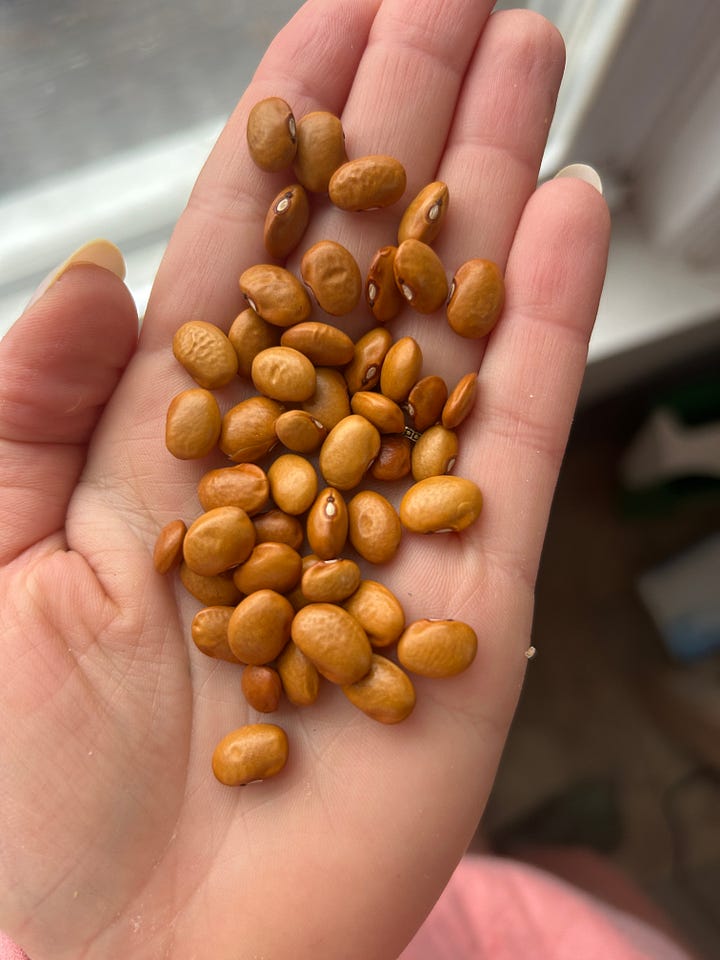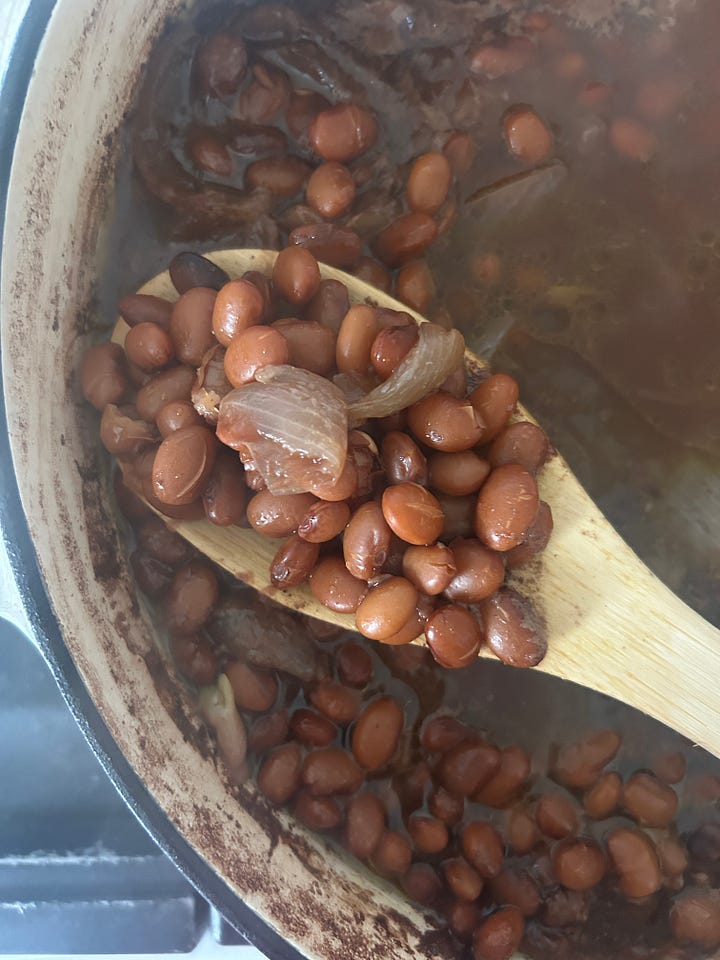

The bean world is pretty small, so when I came across Beanstory, a stunning heirloom bean company with varieties I had never heard of, I knew I wanted to get in touch.
Katherine, the co-founder of Beanstory, lives in NYC, and I wanted to get to know more about how she came to start a bean company, what’s the process like working with small bean farmers, and what she’s learned about growing a CPG company, having never worked in food before.
People often say to me that beans are really in the spotlight and having their moment, but like I’ve said before, the journey to get Americans to eat more beans has just begun! How often are you actually eating beans? Once a week? If you order from Beanstory (their beans are currently on sale to make room for the new harvest coming in), you could add another couple of meals of beans to the rotation. I made 1 pound yesterday and wow, that’s a lot of food. If you are looking for new ways to eat beans, I included a recipe below!
You come from a design background; what drew you to the food world, and how did you start a bean company?
I’d been working in sustainable textile design - and had launched a line of zero-waste rugs and pillows in which I was upcycling gorgeous ‘waste’ fabric from fashion brands. Through this process, I started paying attention to where materials came from, how we were using them, and how we were wasting resources, and I became more conscious of other aspects of my life. I started paying attention to what I was eating and became more curious about the source of my food.
My business partner, Maggie, is a friend from childhood who was going through a similar evolution. At first, she was going to join my textile brand, but we decided to venture into food since it was a more accessible area to create change. You might buy textiles every few years, but we eat every day.
Beanstory was born from there. We recognized beans as a superfood that was underappreciated, and it felt like there was a lot of opportunity to elevate this category.
How did you start to build relationships with bean farmers?
We didn’t know a single farmer when we decided to launch Beanstory, and neither of us had any connections in the food world. So, we started doing a lot of research. We did a lot of digging online, read relevant books and studies, and went deep into search mode. Then, we picked up the phone or emailed farms and started having initial conversations with potential growing partners. We were amazed at how receptive people were to our initial idea. Sure, we got a lot of hang-ups and failed attempts, but for the most part, it was really encouraging.
Once we had a list of target farms, we traveled the country and met with our partners. That was such a fun and eye-opening experience.
Are all your beans from U.S. farms?
Our beans are 100% US-grown, 100% organic (from certified organic growers), and single-origin, and every year, we buy fresh beans from the latest harvest. We work with smallholder farmers who grow interesting heirloom varieties. Smaller farms typically grow these types of beans because they’re not as commercial - it’s harder and more expensive to grow, harvest, and clean heirloom beans. By supporting these smaller growers, we can bring delicious and beautiful beans to market and preserve biodiversity, which will be increasingly important as our climate changes.
One of our partners, Ed Cohen, has a farm in Northern California and he calls these beans “culinary” beans because of their standout taste and texture. Ed is not only organic certified, but he dry farms his beans. That means he doesn’t irrigate the crop when growing.
For some of the heirloom beans, were the farmers already growing these beans or did you pick the varieties together?
Both. We’ve contracted some special heirloom varieties from our growers, and at other times, we’ve sourced beans that were already planted. The challenge is that we never know exactly what we’ll get - some years (and regions and varieties) are productive, others are not.
How do you name your beans? What is the history of the beans called Old Indian Woman?
We consult with our farming partners for names. We had a lot of discussions around ‘old Indian woman.’ When we thought of changing the name, we were told to call it “old” or “yellow,” and we thought we’d go all in and stick with Old Indian Woman. It’s a delicious bean that originated in Mesoamerica - as with other common beans - and then was brought to Europe during the Columbian exchange. These beans are believed to have returned to the US from Sweden sometime in the late 1800s.
What is something you wish you knew about beans or CPG before you started this business?
Good question. I wish we had known more about the economics behind getting CPG brands on the shelves in retail stores. We weren’t aware of so many costs - slotting fees, trade fees, distribution fees, brokerage fees. If I were doing it again, I would start with the retail price we need to hit, the margin we need to make, and then work back from there. However, truthfully, we wouldn’t be able to work with the types of farms we want to support, so in the end, I don’t think we would do things much differently.
What has been one of the most challenging things about building Beanstory?
We’re a bootstrapped brand, and building awareness is expensive nowadays. We were lucky with some good PR early on that didn’t cost us anything (i.e., The New York Times!), but generally, it’s very expensive to build an audience. It’s also much harder to grow a social media following now - everything seems to come at a cost.
What do you say to people who complain about cooking dry beans?
To be honest, we don’t come across a lot of complainers. I think the people who are attracted to our brand already love to cook with beans. We hear complaints about soaking beans - and if you’re in that camp, don’t soak! Our beans are fresh so it’s not something that you need to do with our beans.
Why should people eat more beans?
There are so many reasons! At the top of the list is taste. Beans are delicious. They are so versatile and absorb the flavors of your dish so well - you can throw them into almost any recipe in one way or another. Another key reason is that they’re fantastic for you - full of protein, fiber, nutrients, and minerals. Personally, I feel better when I eat beans, and I like knowing that I’m getting what I need, nutritionally, by eating them.
The reason we launched Beanstory is the positive environmental impact that beans have on our planet. Eating more plants is important, but beans are nourishing for soil as nitrogen-fixing crops. This means they require less nitrogen fertilizers, which leads to less runoff into water streams and other harmful effects…plus they have a host of other environmental benefits.
What’s your favorite way to eat beans?
I love a good pot of brothy beans - and they’re so easy to make. I literally just throw some onion and garlic into a pot, along with maybe a dried pepper, bay leaf, and some salt (and some parmesan rind, if available), and call it a day. Let it slow cook until the beans are tender, and I’ll have a delicious meal. Sometimes, I’ll throw some greens into the pot or top with some roasted cabbage or herbs, but that’s kind of it. It’s one of those meals that doesn’t take any thought or recipe, and you can use whatever you have at home. Plus, I’ll make enough to have leftovers during the week.
Gems of the Week ✨
The destruction of USAID is certainly not a gem of the week, but this coverage from NPR that food aid is grown in the Midwest and that ending USAID programs will negatively impact farmers is an important aspect of the story that needs to be explained.
- wrote a newsletter about Sorghum and what it can do for soil health. She shared an event I’ve had my eye on, which is the Carbon Sponge Sorgum workshops happening in March.
What an ‘America First’ Diet Would Really Look Like - Yasmin Tayag
My friend
started her Substack called fast writing. She is the author of the novel Oval and so much more.Last week, we had an amazing event at Farm to People with Ethan Frisch from Burlap & Barrel. We all learned so much about the history of spices, entrepreneurship, colonialism, and more - The conversation was recorded and will be released soon! We have our next event with a small egg farmer from Horse Shoe Ranch on Tuesday, and there are still tickets if you live nearby.
Cauliflower Mash with Old Indian Woman Beans and Parm ✨
These beans are elegant and easy to cook because they are on the smaller side. Great starter bean for someone new to cooking dry beans. They have a great flavor on their own and my partner was even eating them by the handful.
Ingredients:
1 lb beans (you will have lots leftover)
Bay leaves, onion, garlic
1 large head cauliflower
Butter
Any milk
Parm
Instructions:
At least 3 hours before dinner, get your beans cooking in a large pot and cover them entirely with water. I like to fill my pot halfway with water.
Add in sliced onion, bay leaves, garlic cloves, salt and a glug of olive oil. Bring to a boil and then turn down to a simmer and leave it alone for 1-2 hours. Check after 1 hour to see how soft the beans are. I like to leave my lid on but open on the side.
To make the mash, cut the cauliflower up into florets and bring it to a boil in another pot of salted water; you could also roast if you prefer.
Once soft, add to a blender with 2 Tbsp of melted butter, a dash of milk, and salt and pepper. Blend!











Thank you for interviewing Katherine! I love Beanstory! I’ve gone through so many bags of Beanstory red lentils and Organic White Runner Beans, which are the best large white beans I've ever had and I’ve had more than your average bean :) You are right, "the journey to get Americans to eat more beans has just begun!”